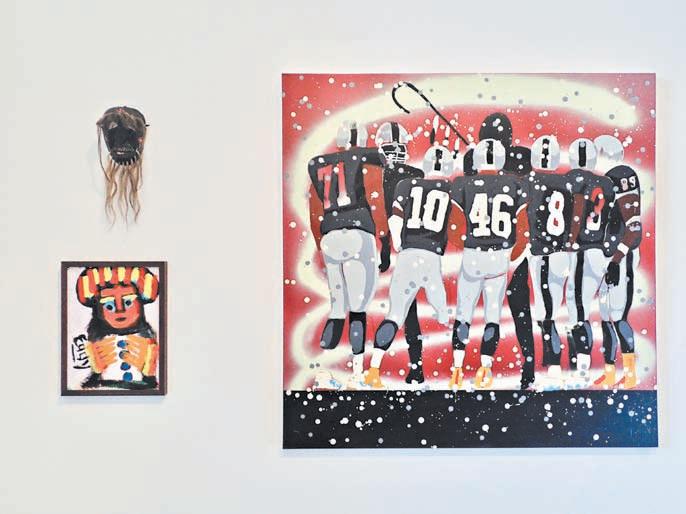
9 minute read
fEAtuRE
from Jan. 31, 2019
L k here
Story and photoS by Kris Vagner
Advertisement
UNR’s new museum might change the way you see art
The exhibition in the downstairs gallery is a collaboration between Toronto-based artist sameer Farooq and reno poet Jared stanely, curated by stephanie gibson from nevada Humanities. Farooq created stream-of-consciousness-type text fragments, visible through these glass panes. Through the opposite sides of the glass, subdued-colored monographs look like abstracted landscapes. The exhibition also contains geological samples and everyday museum-prep materials, borrowed from Unr’s Keck Museum. Keck director garret barmore said in a Jan. 26 gallery talk that the idea was “to show how the museum sausage is made” and give a glimpse into a curator’s sometimes messy workspace. a beaded basket about the size of a tennis ball cut in half is part of a display of Washoe, Paiute and shoshone baskets. This one was made by Celia Delorme. Many works in the Lilley Museum’s exhibition To Have and To Hold—such as baskets and clay vessels—have traditionally been shown in history musuems. The Lilley aims to deemphasize the distinction between art and craft.

Anew art museum opened at the University of Nevada, Reno, on Jan. 25. On the surface, it looks like just what you might expect from a new art museum. The three-story brick exterior blends in with UNR’s other recent constructions, and the lobby and two galleries feel airy and pristine, with glass railings, polished cement floors and plenty of filtered daylight streaming in through large windows.
But you might be surprised by your first glimpse of the artwork, especially if you start on the second floor, where the new walkway from the Church Fine Arts building will deposit you. No blue-chip artists or splashy paintings from the pages of Juxtapoz in this museum. The pieces that greet you first are Hopi earthenware vessels, the kind that are often in history museums. The display case that holds them contains no labels, and the whole exhibition, To Have and To Hold, has no wall text. But packets of exhibition notes are available to borrow, and they’ll tell you that these vessels are not labeled “anonymous Hopi from a previous century” but made by people with actual names, such as Adelle Nampeyo from Arizona, born in 1959 to a well-known family of potters.
The exhibition also includes beaded baskets by Washoe and Shoshone tribe members, a 10-inchlong, three-horned ceramic rhinoceros from about third-century China, paintings by Rousseau and Dali, an Albrecht Dürer print from the early 1500s, and some of the gallery’s recent acquisitions of work by African American artists from the 20th and 21st centuries.
continued from page 11

A sculpture and a painting present two very different views of American landscapes. The painting in the background, “Southwest Sunset,” was made by postwar American abstractionist David Einstein in 1972. The sculpture in the foreground, “Only Tree (With Nest)” is a cast bronze and steel tree made in 2018 by contemporary Cherokee artist Emily Arthur. The exhibition To Have and To Hold contains several juxtapositions of objects that raise questions about how motifs and symbols work. Here, in the foreground, a tule duck by Joe Allen, a Stillwater Paiute, adheres to a traditional aesthetic, while in the background, a Navajo rug contains a swastika symbol, the implications of which have changed over time. The swastika was used in several cultures around the world to express notions such as peace and prosperity until the Nazis adopted it in 1920. This rug was probably made some time between 1870 and 1905.



The exhibition To Have and To Hold contains artworks from many regions and many time periods. Rather than being organized by place or time, however, it’s organized by themes. This piece, “Acoma Wedding Pot,” by 20th-century artist E.P. Routzen, is in a section of the show that addresses courtship and family. The exhibition contains no wall text, but for visitors who like more context about artists, dates, titles and the show’s organizational principles, a packet of information is readily available to borrow. Arti
st
These works, pulled from UNR’s collection of around 5,500 pieces, are arranged not by era or region, but juxtaposed in ways that invite telling comparisons. From one vantage point, you can see a woven tule and cattail duck, made in 2015 by Shoshone Paiute tribe member Joe Allen, who stayed true to traditional imagery. Beyond the duck is a piece that might upend—or even offend—your notions of traditional imagery. A bright red, wool and cotton rug, decorated with what appear to be Nazi swastikas, hangs on a rack. It’s not there to tout anti-Semitism or white supremacy. It’s there to point out how symbols are used. The rug is Navajo, made sometime between the 1870s and 1905, after the swastika was used in India and Greece, before Germany’s Third Reich adopted it. Some Great Basin tribes also used the symbol before the Nazis did and later made a pact to not use it. In recent years, a few young Native Americans have made moves to reclaim it. Meanwhile, the version that’s hanging on a display rack in the Lilley can easily come off as shocking.
“It’s provocative—it’s arresting,” said museum director Paul Baker Prindle. “But I think there are a lot of ways to talk about it.”
And that is the whole idea behind this museum—to talk about how art and artifacts inform us, and who’s traditionally made the decisions about how that should work. Although, here, the distinction between “art” and “artifact” is one that Baker Prindle would like to see minimized. Museums—art museums and history museums alike—have long been guilty of supporting colonialism, creating what Baker Prindle called “false distinctions between art and craft,” with “art” made by wealthy, white, European men and “craft” made by pretty much everyone else.
Baker also put “propping up gender divisions” on the list of traditional art-world habits he’d like to see reconsidered. If you’re wondering what that means, here’s a timely side note: seminal feminist artist Judy Chicago spoke at the Nevada Museum of Art last week and told a story about working in Pasadena in the 1960s, the only woman in a thriving art scene, always ignored by critics. Decades later, a critic told her he had recognized the merit of her work but taking a woman artist seriously would have spelled career suicide for him. In another timely side note, Reno artist Tia Flores said in an interview last week that, early in her career, advisors insisted she go by “T. Flores,” as no one with a female first name stood a chance of establishing a career. In a lot of other timely side notes, women artists who came up before the 1990s or so tell versions of that same story all the time.
Changing times for museums everywhere

“The entire [museum] field has been having a philosophical discussion for the last 20 or 30 years,” said Garret Barmore, director of another museum at UNR, the Keck Earth Science And Mineral Engineering Museum. Some of the industry goals he listed are “to be more accessible, decolonize, directly address the racist history of museums past.”
These goals are being addressed internationally. France’s President Emmanuel Macron, for one, announced in November that a Paris museum would return 26 objects, seized by French colonizers in 1892, to the West African nation of Benin.
They’re also being addressed close to home. In 2002, the Nevada State Museum in Carson City replaced its exhibition of Native American wax mannequins and dioramas from the 1940s with a new exhibition, Under One Sky.
“They invited a community advisory of Native Americans,” said Barmore. “While this sounds like a no-brainer, it’s something that museums are still struggling with, to bring in the communities they’re interpreting.”
In the Nevada State Museum exhibition, Barmore said, “Native people themselves are talking, telling their own stories—no mannequins.” Changes are on the horizon for the Keck Museum, too. “The only perspective is the white, male geologist and historian,” Barmore said. “We want a more diverse story. … I would like to have a more diverse interpretation of the Comstock and Virginia City mining. Right now, the only story told about Virginia City city is that of the rich, male miners. … I want to bring in Native American groups to talk about how they interact with geology. There’s been ancient mining going back in Nevada for thousands of years. [I want to] tell that story.”
And at the Lilley Museum, Baker Prindle explained, one of the big questions to reexamine is: “What responsibilities and what functions do museums have in the production of knowledge? And those fundamental questions lead to a lot of other questions. We ask ourselves, ‘Who do we serve? Who are we responsible to?’”
As many people as possible, he hopes. Ω
Another innovative juxtaposition contains three types of representational artworks that don’t often meet on the same gallery wall. Top left, a wooden mask by Yaqui artist Jesus Rodriguez Muñoz. Bottom left, an untitled 20th-century painting by Eddy Mumma, a well known “outsider” artist—that’s an artist without formal training who’s often isolated from the national art market. Right, a 2017 acrylic by Frank Buffalo Hyde, an Onondaga-Nez Perce artist who lives in Santa Fe and often incudes both Native American and consumer-culture imagery in his paintings. The Lilley Museum is now open at UNR. It connects to Church Fine Arts via a walkway and is accessible from the Whalen parking garage. Curently, hours are Tuesdays through Thursdays 12-4 p.m., Fridays noon-8 p.m. and Saturdays 10 a.m.-8 p.m. A grand opening for the building, including a recital hall and other rooms, will be held at 5 p.m. on Feb 22, after which gallery hours will be expanded. To keep up to date on event dates and other news, follow The Lilley Museum on Instagram. Admission is free.
Advertise in fAmily guide


Every year the Reno News & Review publishes four special FAMILY pullout sections aimed to help modern parents navigate the uncertain role of parenting. These will cater to parents of children ages 0 – 18 and feature sections covering the spectrum from pregnancy to empty nest, as well as identify family-friendly parts of our community. The issue drops on February 21st. Don’t miss this opportunity to reach families in Washoe County, Carson City and Douglas County with your message!


Modern familiesFrom babies to grandparents, RN&R’s family guide explores how technology affects our lives
Family Guide May 2018
Space reServation deadline: February 14
ContaCt your aCCount exeCutive for rates and information 775) 324-4440













